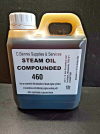newboydave
G scale trains - no surprise there then!</br></br>
I have an Accucraft "Lawley" (2005 model) which has suddenly started to show signs of oil in the sight glass - still runs OK, but of course now I can not see the actual water level. I have tried cleaning the inide of the glass, but next time I run, the oil appears again. Any suggestions on possible causes, or remedies to correct this situation would be appreciated.


![20250104_182415[1].jpg 20250104_182415[1].jpg](https://cdn.gscalecentral.net/2025/01/thumb/530805_20250104_1824151.jpg)